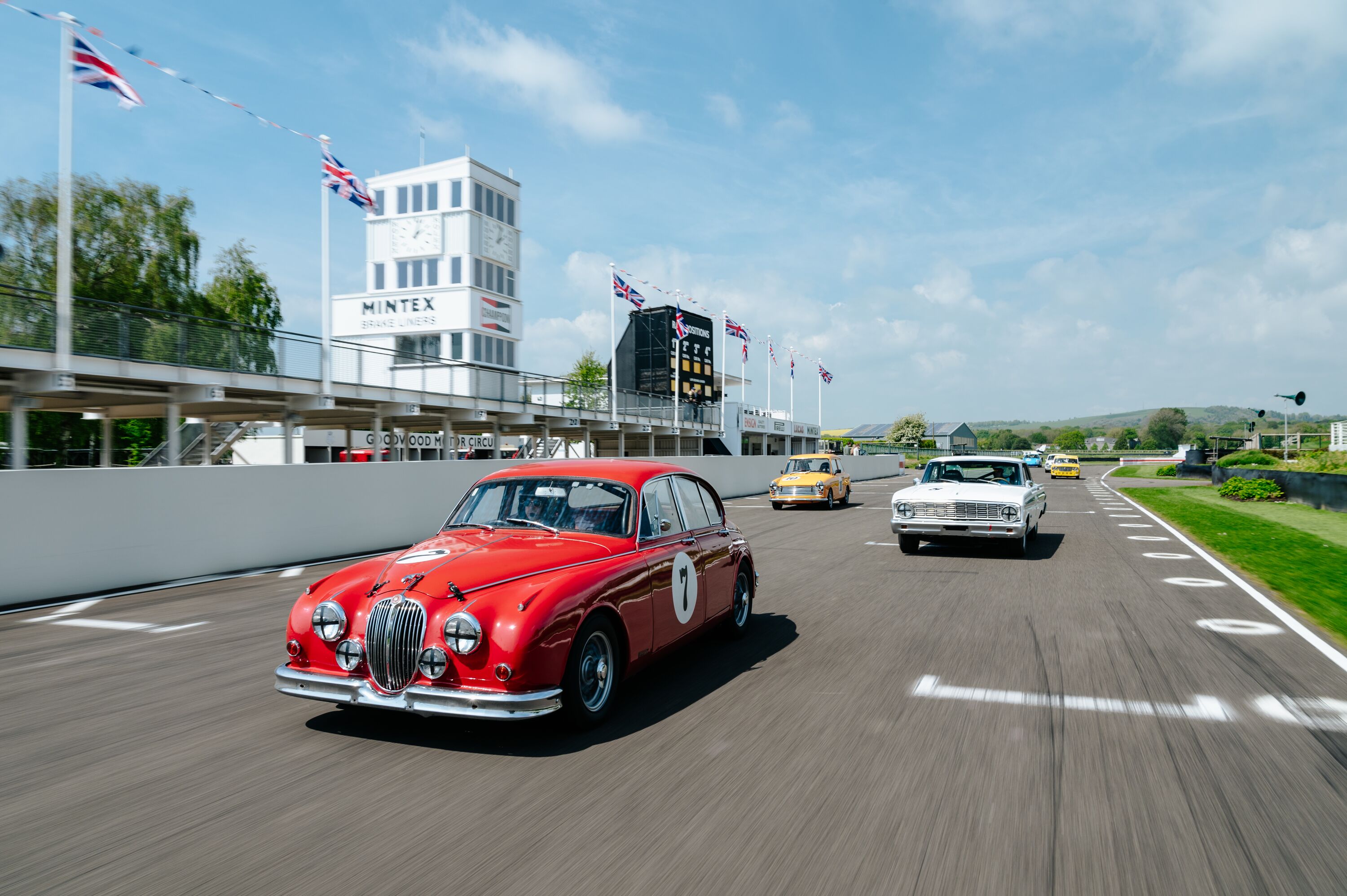When Hunt beat Lauda… in 1975
The first one is always important, always a landmark. For James Hunt it was especially so, because his first Formula 1 World Championship Grand Prix victory was proof, finally, that he had it in him to be truly world class.
The day his plucky Hesketh beat old flatmate and future World Championship rival Niki Lauda in a mighty Ferrari, at the Dutch Grand Prix on 22nd June 1975, changed Hunt’s life. As we gear up to celebrate ‘The James Hunt Years’ at the 83rd Members’ Meeting presented by Audrain Motorsport next year, let’s look back on a maiden Grand Prix victory that laid the foundation stone for his incredible 1976 success.

The rise of Hesketh
The old, mean (but also sadly accurate) ‘Hunt the Shunt’ nickname hadn’t quite been shaken off by the summer of 1975, but Hunt had already proven that he’d matured from the fast but wild racer who had bulldozed his way through Formula Ford and Formula 3. In F1, he still made mistakes, but far fewer — and the evidence was already there that he was thriving and at home living at motorsport’s pinnacle.
Lord Hesketh’s faith in ‘Master James’ had begun to pay off from the moment they embarked on their audacious F1 adventure. In a rented March 731, Hunt scored a point for sixth in only his second Grand Prix, in France in 1973, then quickly followed up with fourth in Britain, a podium third at Zandvoort and at season’s end a fine second at Watkins Glen, where he hounded Ronnie Peterson’s Lotus to the chequered flag.
Hesketh stepped up as a fully blown constructor in ’74, with Hunt maintaining his momentum with a first F1 victory in the non-championship Daily Express International Trophy at Silverstone.
Reliability woes checked the progress through the rest of the season, although with a trio of third places in Sweden, Austria and the US his reputation continued to rise. Dan Gurney hired him for Formula 5000 appearances in the States, and he even made a cameo for John Wyer’s Gulf-Mirage sportscar team, scoring a fourth place at the Nürburgring 750Kms with Vern Schuppan and Derek Bell.
In the wake of Jackie Stewart’s retirement at the end of 1973, James Hunt was now Britain’s top Grand Prix driver. Few would have predicted that at the dawn of the decade.

The momentum is lost
From the start, Hesketh divided opinion, both within the F1 paddock and among enthusiasts. The parties, champagne and good-time approach, all funded without commercial backing and directly by a young, extravagant aristo… It wasn’t to everyone’s taste. Even 50 years ago, this team was out of its time, a throwback to a previous age.
But to suggest Hesketh wasn’t professional would be a mistake. Hunt wouldn’t have scored as he did over 1973 and ’74 without a team with genuine backbone.
Nevertheless, reality was beginning to bite during 1975. Lord Hesketh was all too aware he couldn’t keep spending his family’s money at this rate — and outsiders began to see a change in attitude. At Monaco, for example, Autocourse noted how not only did Lord Hesketh use a motorhome for the Grand Prix weekend, “he actually slept in it.” The previous year, he’d had two yachts — one for sleeping on, one for parties — a helicopter and a Rolls-Royce on hand.
Results-wise, the team was slipping, too. The season had started with a flourish, as Hunt finished second to Emerson Fittipaldi’s McLaren in Argentina. He then followed that up with another point scored in Brazil. But after that, five races passed without Hunt passing the chequered flag. What a letdown. How long could this go on?

Ferrari in the ascendance
All the evidence pointed towards another Ferrari win at the Dutch Grand Prix. A year earlier, the red cars had dominated at Zandvoort and now Lauda was fully in his stride in the beautiful, new 312T. The Austrian had won the previous three Grands Prix, at Monaco, Zolder and Anderstorp, and here at Zandvoort stroked to a comfortable pole position.
Hunt was a best-of-the-rest third on the grid behind the other Ferrari of Clay Regazzoni, with Jody Scheckter’s Tyrrell right behind him. Then on race day it rained. That changed everything.
No Sunday morning warm-up had been arranged, but in the wake of a downpour one was hastily scheduled. But would it be wet for the race itself? Spits on the grid left little choice: it was treaded rubber all round as the 1975 Dutch Grand Prix began to roll.
Lauda took the lead from the start, with Scheckter slotting into second as Regazzoni bogged down. The Swiss quickly recovered and was soon third, ahead of Hunt’s Hesketh. And then the rain stopped — the track a stone’s throw from the North Sea coast quickly began to dry. Slick tyres would soon be vital.

Hunt’s inspired pitstop
But when to stop? That turned out to be the crucial question. On lap seven, Hunt took the initiative and headed for the pits, followed by Jochen Mass in his McLaren.
In Monaco, Hesketh had made a meal of a tyre change, so the team had spent time working on its weakness, and just as well. Hunt was stationary for about a minute — a disastrous age today but about par for the course back then. He and Mass rejoined in 19th and 20th respectively. “It’s quite a tricky decision to make,” Hunt later reflected, “because although the racing line might be dry enough for slicks you have only two very narrow dry strips in which to run and if you go only a few inches off line you’re on wet.”
Precision driving was required, but Hunt proved equal to the task. And now everyone else needed their own sets of slicks.
Lauda waited until lap 13 before taking on his own, and as he re-emerged back on track, there was Hunt. The white Hesketh darted into Tarzan ahead of the Ferrari and now had the lead of the Grand Prix. The term ‘undercut’ springs to mind, though it would be decades before such a word entered F1 parlance.

Lauda on the Hunt…
Before the World Championship leader could think about the Hesketh, he had a pesky Shadow to worry about. Jean-Pierre Jarier even passed Lauda for second place and it took the Austrian until lap 43 (of 75) before he could find a way back through. Two laps later the distraction was gone. One of Jarier’s rear tyres exploded, probably because of debris.
Now Lauda set his sights on his friend up front. Would Hunt crack? As he would admit years later, he had so little experience of leading motor races it was only when he made it to F1 that he began to discover what it was like. There’s a knack, a pressure that must be dealt with. In essence, Hunt needed to learn how to win.
He had led Grands Prix before, but there were instances where he’d made a mistake and spun. Now the Ferrari closed in as Hunt negotiated backmarkers, in the knowledge one slip would give Lauda his chance. “I sometimes had to be pretty brave to get by other cars, because I had to line them up and do it before we got to a bad place,” said Hunt. “If I’d got stuck into the corner before the straight, for instance, Niki would have been by like a shot.”

But the mistake never came. In fact, Hunt drove a perfect race and didn’t put a wheel wrong. This was how it felt to properly lead a Grand Prix, in the face of all too obvious pressure from a guy in the form of his life — and this is how it felt to win. Hunt crossed the finish line just a second clear of the man who would go on to claim his first World Championship later that season.
What a day for Hunt, for Lord Hesketh, for the whole team, and for Britain. No one was turning their nose up at the ‘Hooray-Henry’ team now.
Yet five months later, the patron faced sad reality. His own self-imposed deadline to find sponsorship had passed and he pulled the curtain on his time in the F1 frontline. The team limped on, but never got close to such glories again.
As for Hunt, left seemingly high and dry, fortune was about to fall his way. When Emerson Fittipaldi sensationally announced he was quitting McLaren for his brother Wilson’s Copersucar-backed team, a new door opened. McLaren required a top-line driver to lead it into 1976, and James Hunt was just about the only serious option.
What followed was one of the greatest F1 stories of them all. But without Hesketh, and the proof at Zandvoort in the summer of 1975 that Hunt was indeed the real deal, none of it would ever have happened.
The 83rd Members' Meeting presented by Audrain Motorsport takes place on the 18th & 19th April 2026. Tickets are on sale now for GRRC Members and Fellows.
You can sign up for the Fellowship now. Click here to find out more.
Images courtesy of Getty Images.
formula 1
f1
f1 1975
james hunt
Hesketh
members' meeting
83rd members' meeting
83MM
The James Hunt Years








